Ductless HVAC Guide: Mini-Split Systems Benefits, Options & More
Dec 7, 2015
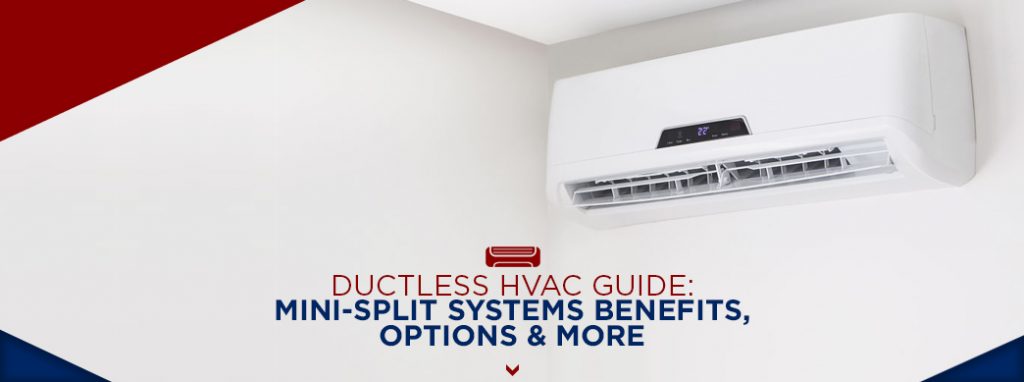
Table of Contents – Jump To:
What Are Ductless Mini-Splits? | Single-Zone vs. Multi-Zone | The Components of a Mini-Split System | How Do Mini-Split Systems Work? | Is Ductless a Good Option for My Home? | Drawbacks of Ductless Systems | Ductless Mini Split Options | How Many Mini Splits Do I Need? | What Size Mini-Split Do I Need? | How Long Do Ductless Systems Last? | How Much Do They Cost? | How Much Energy Do You Save? | Ductless HVAC Installations
Mini-splits, also known as ductless mini-splits or ductless heating systems, are a convenient alternative to central heating and cooling systems. In this ductless heating and cooling systems guide, we’ll explain how these systems work, the many benefits they provide, how to find the best ductless air conditioner for your home and how to install them.
What Are Ductless Mini-Split Systems?
Mini-splits have a lot in common with many other heating and cooling systems: They have an outdoor condenser and indoor air-handling unit, and many mini-splits provide both heating and cooling. The primary difference between mini-splits and most other air conditioning systems is that mini-splits don’t have ducts.
Ductless mini-split systems have many applications in residences and commercial buildings, although their most common use is in multifamily housing or as add-ons in homes with existing heating systems that don’t use ducts. They’re also common in smaller apartments where it may not be feasible to extend or install distribution ductwork for central heating or cooling systems.
Single-Zone vs. Multi-Zone

There are two classifications for mini-split systems: single-zone or multi-zone.
- A single-zone system heats or cools an area or your house using one indoor and one outdoor unit. This type is common in bedrooms and other rooms that do not have central air conditioning ducts. If you have a single-zone AC unit, the most significant consideration is whether it can cover the square footage of your room.
- A multi-zone mini-split functions just like a single-zone system, but heats or cools more parts of a business or home. Multi-zone units, each of which represents a zone, connect to a single outside unit via the refrigerant lines. Generally, a home can have a maximum of four indoor zones. If your home doesn’t have a central air conditioner, you may want to consider a multi-zone system for cooling different parts of your house, which, thanks to long refrigerant lines, can be one more than one floor. Multi-zone units are most common in places like apartments, basements and doctors’ offices. The single outdoor unit can handle all the interior units, although in this case, we do not recommend setting all four interior units to the highest level simultaneously.
What Are The Components of a Mini-Split System?

Ductless mini-split systems consist of two main parts: an outdoor unit and an indoor unit. The outdoor unit contains three main components, which include the following.
- Compressor: The compressor is one of the most essential components — as well as the most expensive. The compressor serves to convert a low-pressure gas into a high-pressure gas, allowing the transfer of thermal heat to occur more efficiently.
- Condensing coil: The condensing coil, or condenser, is a lattice-like structure that consists of many aluminum fins. It cycles hot refrigerant and converts it from a high-pressure gas to a high-pressure liquid.
- Fan: The fan pushes air through the condenser, helping the stored heat energy escape to the outdoor environment.
The indoor unit is also called the air handling unit, and you’ll usually see it mounted on a wall or suspended from the ceiling. This unit contains a fan that blows the heated or cooled air into the room. Thin copper tubing connects the outdoor unit to the air handling unit. This tubing carries refrigerated coolant, which is responsible for both heating and cooling.
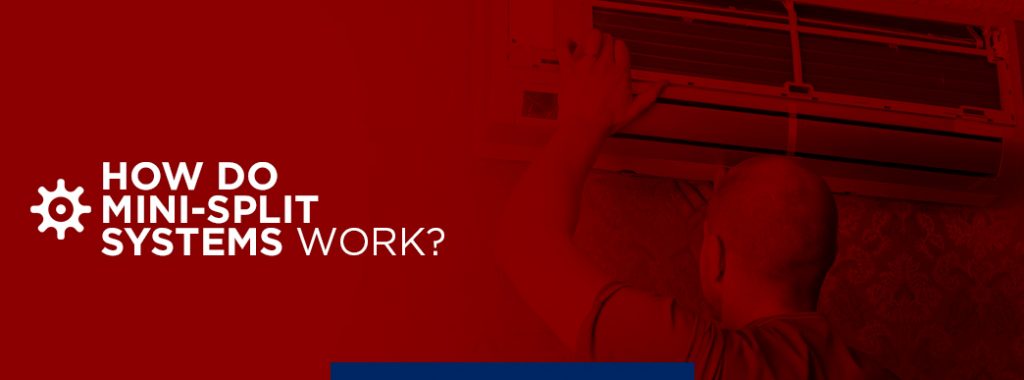
How Do Mini-Split Systems Work?
The way mini-splits work is remarkably simple, and we can sum up the process in four steps.
- Hot air gets sucked in: The handling unit — which is what you see mounted on the walls of homes and businesses —takes in air from the room. The air then travels through a series of pipes to the condenser, which is outside.
- The energy in the hot air gets transferred to coils: When the humid, hot air reaches the condenser, which consists of many coils that contain coolant, the energy gets transferred to the coils. The result is that the coolant liquid gets turned into a gas.
- The coolant gas gets converted back into a liquid: The coolant gas then travels to the compressor section of the condenser unit, where it gets recycled in an electrical process that converts the gas back into a liquid.
- Cool air gets pumped out: The recently cooled air passes through a handler, where it gets ejected back into the room. With repeated cycles, the room’s temperature drops.
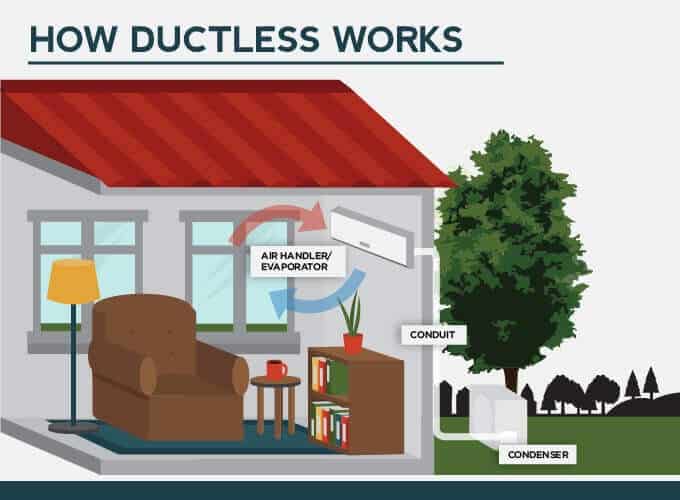
Many contemporary mini-split systems handle both heating and cooling. However, it’s possible to find mini-split systems that do just one or the other. Systems that offer heating or cooling alone may cost a bit less than one that provides both.
A mini-split system with both heating and cooling will offer you the most flexibility. If you live in an extreme climate, choosing just one may make more sense. For instance, in a hot climate with mild winters, you might want a mini-split air conditioner.
You’re likely to use your mini-split system more often if you live in an extreme climate, so choosing an energy-efficient mini-split will be more critical. Look for a unit with a high seasonal energy-efficiency ratio, or SEER.
Most mini-split systems will work in climates as cold as -15 degrees and as warm as 115 degrees Fahrenheit. Your mini-split should have no problem with Central Pennsylvania’s summers and winters.
Is Ductless A/C a Good Option for My Home?
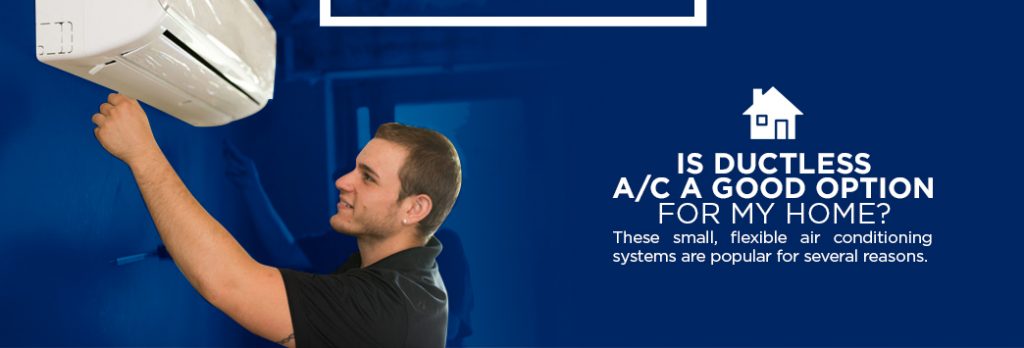
These small, flexible air conditioning systems are popular for several reasons. Let’s look at some of the most significant benefits of ductless HVAC systems.
- Flexible solutions: While more traditional heating and cooling systems push heated and cooled air through ducts, mini-splits directly deliver air to zones. Ductless air conditioner options are a cost-effective solution for home and business owners with inefficient electrical baseboard heaters, space heaters or window air conditioning units. You can install them in new constructions, home additions, apartments and condominiums, or to improve the temperature control of specific rooms. You can even use mini-splits for buildings that already have a ducted system.
- Easy installation: Mini-splits are typically easier to install than other heating and cooling systems. For instance, the conduit that connects the indoor and outdoor units usually only requires a three-inch opening through the wall, and mini-split manufacturers can generally offer a wide variety of conduit lengths. The outdoor unit can be as far as 50 feet from the indoor unit if needed. This installation option allows you to cool a room located in the front of a building or house and put the outdoor unit in a less conspicuous place on the side of or behind the building.
- Energy efficiency: Since mini-splits are ductless, they don’t experience the energy losses associated with ducted heating systems — the air travels straight from the system into the room. The loss of energy through ductwork can account for over 30% of the energy traditional central forced-air systems consume, especially if the ducts pass through attics or other unconditioned spaces. Energy Star-certified mini-splits consume 60% less than conventional electric heating and cooling systems. This efficiency leads to significant cost savings of ductless HVAC.
Better temperature control: If you have multiple mini-split units installed in your home, you can control the temperature of each room, which is more energy-efficient than using a thermostat to control the temperature of your entire house. If the occupants of a home cannot agree on a single temperature, mini-splits are an ideal solution. Also, if you primarily use one room of your house, using a central heating or cooling system is wasteful. - Flexibility in design: In comparison with other heating and cooling add-on systems, mini-splits provide homeowners with more options for interior design. You can hang them on your wall, suspend them from your ceiling or mount them flush into a drop ceiling. You can also buy models that stand on the floor.
- Safety: Because ductless mini-splits only require you to bore a small hole in your wall, they help keep your house safer. Air conditioners that go through the wall or the window, on the other hand, make it easier for intruders to enter.
- Easy control: Although installers of mini-split units often mount them high on a wall or suspend them from a ceiling, it is easy to turn ductless mini-splits off or on with a remote control.
- Better air quality: Homes with mini-splits often enjoy better air quality than those with central heaters. Systems with ductwork collect mold, dust, pollen and volatile organic compounds, which can negatively affect the air quality of your home. Since ducts remain out of sight, most homeowners don’t think to clean and maintain them. Even if you get them professionally cleaned, pollutants may remain. With mini-splits, not only are there no ducts to collect these potentially harmful things, but they also feature multi-stage filtration designed to significantly reduce particulates such as dust, pollen, bacteria and allergens. You and your family will be healthier as a result.
- No maintenance or cleaning costs: Systems with ductwork require routine cleaning and maintenance, which you typically pay a professional to perform. With ductless mini-splits, you can take care of the upkeep yourself, which will save you money and time.
- Multiple modes of operation: Mini-splits typically offer several operating modes. In additional to the standard cooling and heating, mini-splits also provide the option to dehumidify. They are ideal for humid climates, which can make the atmosphere in the home uncomfortable and degrade fixtures over long periods. They also offer a fan-only option, as well as sleep and automatic functions.
Learn more about Ductless Installations
Drawbacks of Ductless HVAC Mini-Splits
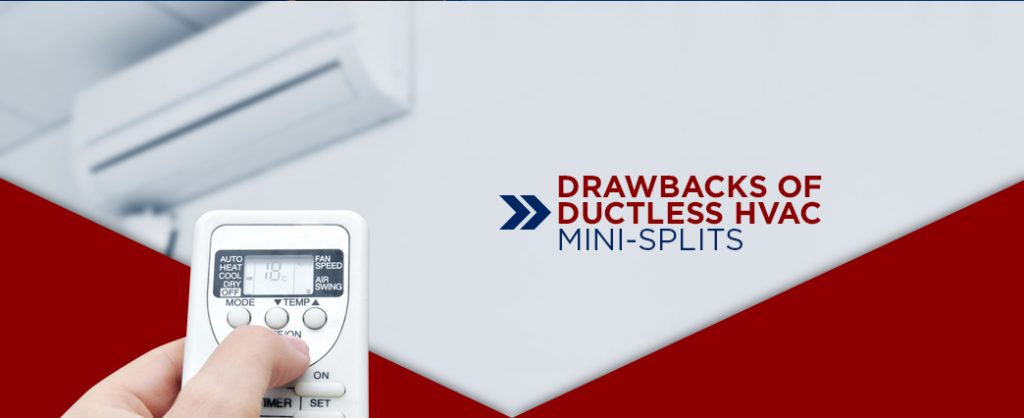
There are also a few potential downsides to owning a mini-split system.
- They may not be aesthetically pleasing in some situations: Depending on the room, the interior unit may not match the general color scheme of your room or appear too “blocky.” These systems are available in a wide variety of designs, however, so in most cases, you should be able to find one that is suitable.
- They require regular maintenance: While the maintenance required with mini-splits is not nearly as involved as it is for ducted systems, you’ll still need to wash the filters once a month — more frequently if you’re a smoker or own pets. If you neglect cleaning your mini-split, it won’t be able to handle the accumulating debris, and you will need to arrange professional cleaning, which will cost you hundreds and may decrease your system’s lifespan.
- There are more upfront costs: If you only use them for a single room, ductless mini-splits are several times more expensive than comparable baseboard or window units. Also, if you were to replace the existing central heating or cooling system in your home with mini-splits in every room, it may be two or three times costlier than just replacing it with another ducted system. However, you will eventually recoup the cost with lower energy bills. How long it takes to recover your costs will depend on the climate of your region, how often you use your system and the price of electricity in your area.
- They may not be sufficient for frigid climates: If you live in a region that typically experiences sub-zero temperatures, you will probably want to get a fuel-based backup. However, there are some newer models designed to keep you comfortable even in negative temperatures.
- Finding a qualified installer could be a challenge: Some HVAC professionals do not have experience working with mini-splits. The installer you choose should be able to install and size the system properly. If the mini-split is too big, it will consume more energy than is necessary, and if it’s too small, it won’t be able to effectively cool or heat the space.
- They make some noise: When most people think about ductless heating systems, they think about older units. Ductless heating systems first came into use in the ‘70s. These units were loud and not particularly energy efficient, so it’s no surprise that one of the most common questions we hear is about noise. Modern mini-split systems, however, are different. They’re much quieter than the original models, due in large part to technological advances. Variable speed compressors and variable fans both help minimize noise. The majority of models still make a low “whooshing” sound, which results from the fan blowing cold or hot air out of the unit. The noise is similar to what a ceiling fan makes. If you would like complete silence, you may not want to consider a mini-split system.
Although the factors above may be drawbacks for some people, we believe the pros greatly outnumber the cons.
Learn more about ductless systems in PA
Should I Get a Ductless HVAC System?
Ductless mini-split systems are seriously worth considering if any of the following situations apply:
- Your home is older and doesn’t have ductwork or a central HVAC system installed.
- You would like to condition the air in a part of your house your central HVAC system does not service, such as an addition or a garage.
- You would like to update your central HVAC system with a system that doesn’t need ductwork.
- You would like to condition the air of individual rooms in your house.
- A member of your household has allergies.
What are the Ductless Mini-Split Air Conditioner Options?
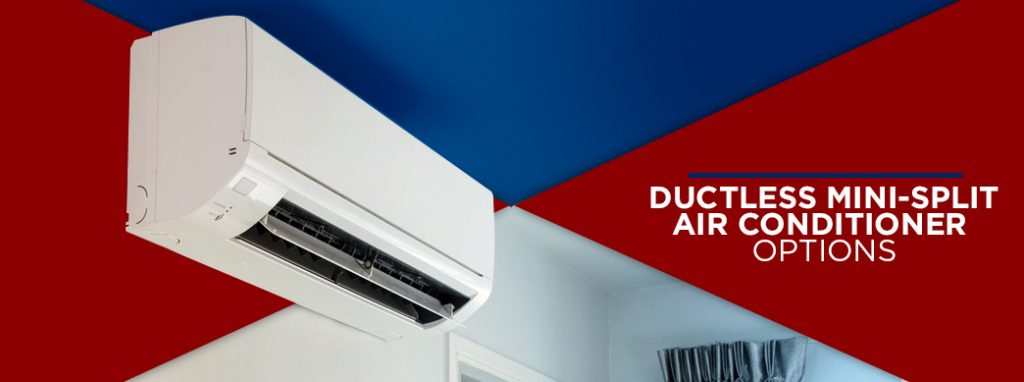
Ductless mini-splits are available in many different types and can go on the floor, wall or ceiling.
- Wall-mounted: Wall-mounted mini-splits are the most popular type of mini-split system. They work well in all room types and are the most affordable mini-split system available. This type of mini-split comes in a wide variety of styles.
- Ceiling cassette: This type of mini-split consists of two main components: an indoor unit, mounted on the ceiling, and an outdoor unit. If you would prefer your indoor unit to remain out of sight, you should consider a ceiling cassette. Also, these systems produce an air flow that is wider than their wall-mounted counterparts. These quiet, efficient systems blend in well with overhead space and come with a handheld remote that senses temperature and provide three different fan speeds.
- Concealed duct: Like ceiling cassettes, concealed duct mini-splits are also ceiling-mounted, where they can connect to other ducts leading into other nearby rooms. These systems are remarkably flexible and are an outstanding option for heating or cooling several bedrooms or one expansive room that requires several vents.
- Ceiling-suspended: This type of mini-split system also mounts on the ceiling and works well for people short on wall space. They are more discreet than cassette mini-splits, making them a good choice if you don’t want to draw too much attention to your unit.
- Floor-mounted: These units sit on the floor and rest against a wall, and are another excellent option if you don’t have enough wall space higher up.
- Indoor air handler: This type of mini-split system is not fully ductless, but is a good option for those who want a large amount of air delivered to several large rooms while using other types of mini split systems in other rooms. If you plan to replace your traditional forced-air system with a mini-split system, you can use your existing ducts with an indoor air handler to force the heated or cooled air through to large open-space rooms. If your kitchen, dining room and family room are in the same part of your house, you won’t need to put in multiple units to serve these three rooms. An air handler can deliver lots of air to these places via discreet vents.
DO I NEED A MINI-SPLIT FOR EVERY ROOM IN MY HOUSE?
Homeowners commonly overestimate the number of mini-splits they need for their residential space. As a general rule of thumb, it’s efficient to install one air handler per room if you consider the area to be a high-traffic location. Bedrooms, living rooms and dining areas are excellent places for ductless systems, as your loved ones likely spend hours at a time in these spaces.
How many mini-splits do you need? On average, roughly four mini-splits will connect to one outdoor unit for a multi-zone system. Speak to your technician about recommendations as to where to place your air handlers, paying special attention to windows, exterior doors and household appliances for successful heating and cooling.
Ductless systems will naturally move your choice of warm or cold air around the house based on your lifestyle and daily habits. Keeping doors open will allow for increased air circulation to areas without a mini-split.
DECIDING ON YOUR NUMBER OF MINI-SPLITS
There’s no magic number for how many mini-splits your home should have. These installations give property owners flexibility when they mount the technology because of the option to span multiple floors. As long as you abide by the rule of four air handlers per outdoor unit, you can heat and cool various levels of the home in stages.
In other words, incorporate a ductless system on the first floor and work your way up. A two-story house might utilize eight mini-splits with two separate compressors outside, for instance. The number of mini-splits you have and their level of power will be influenced by square footage, ceiling heights and environmental factors. Fortunately, HVAC professionals rely on a formula for selecting air handler strength, size and mounting location. If you live in Central PA feel free to contact Home Climates to get professional advice on how many mini splits are right for your home!
What Size Mini Split Do I Need?

To determine the size of your mini-split, the first thing you must do is calculate the area of the room you want to heat or cool. Each unit can provide a specific number of BTUs of heating and cooling power. One BTU, or British thermal unit, is the amount of energy needed to raise the temperature of water by one degree Fahrenheit.
BTU is a marker of how much space an HVAC system can heat or cool. Small air conditioners might be rated at just 5,000 BTU, which can cool about 100 square feet. Larger air conditioners can have a capacity of up to 34,000 BTU.
You must ensure your mini-split system has the proper capacity. If the capacity is too small, your mini-split system won’t heat a room effectively.
Many people mistakenly think higher-capacity systems are more effective, but this is not always true. An oversized mini-split system will waste energy. Oversized air conditioners can also leave too much humidity in the room, causing a clammy, uncomfortable feeling.
Other things can affect the capacity you need as well. Mini-split systems used in sunny rooms or kitchens, for instance, need more capacity. You might also need more capacity for rooms with many occupants. On the other hand, you’ll need less capacity for heavily shaded rooms.
Working with a qualified technician is the best way to determine your capacity. They’ll be able to estimate your usage, determine the most effective zones and recommend the best multi-split system. You can also get an estimate of how much capacity you’ll need based on your square footage.
To find the number of BTUs required for your space, check the square footage of your room against the table below.
- 150 to 250 square feet: 6,000 BTUs
- 250 to 300 square feet: 7,000 BTUs
- 300 to 350 square feet: 8,000 BTUs
- 350 to 400 square feet: 9,000 BTUs
- 400 to 450 square feet: 10,000 BTUs
- 450 to 550 square feet: 12,000 BTUs
- 550 to 700 square feet: 14,000 BTUs
- 700 to 1,000 square feet: 18,000 BTUs
- 1,000 to 1,200 square feet: 21,000 BTUs
- 1,200 to 1,400 square feet: 23,000 BTUs
- 1,400 to 1,500 square feet: 24,000 BTUs
Here are some other factors you should consider when choosing the right BTU value for your space.
- Climate: If you live in a region where temperatures often exceed 90 degrees Fahrenheit, increase the BTU value by 30%.
- Insulation: If your space is poorly insulated, increase the BTU value by 30%.
- Ceiling Height: If the ceiling height is more than eight feet, increase the BTU value by 20%.
How Long Do Ductless HVAC Systems Last?

When investing in a mini-split, especially if you live in a particularly hot or cold climate, you want to be sure the unit you’re buying won’t fail anytime soon. The longevity of a mini-split system depends on several factors.
- Whether you perform routine maintenance: If properly maintained, most mini-splits will last around 20 years, which is significantly longer than the 12- to 15-year lifespan of most conventional heating and cooling systems. For this reason, you can be fairly certain your mini-split will keep you comfortable for longer than most traditional systems. However, you must have an HVAC company maintain your mini-split regularly. Just like any other appliance, your mini-split can perform its best when you properly repair and care for it.
- How often you use it: It’s obvious a rarely used system will last longer than a system that sees daily use. However, regardless of how often you use it, a high-quality mini-split should still last close to 20 years.
- The quality of your unit: Not all ductless mini-splits are equal. As is the case with many appliances, the more economical options feature cheaper materials, so don’t buy a mini-split just because the price is good. It’s better to speak with an HVAC professional who can point you toward a mini-split product that will last a long time.
How Much Does A Ductless HVAC Installation Cost?
The average cost of a ductless HVAC mini-split ranges from $1,300 to $4,500, with a 12,000-BTU system costing approximately $2,000. A unit that weighs one ton with one indoor and one outdoor component with a 21 SEER rating costs between $1,000 and $4,000, with the indoor mount type and brand most influencing the cost.
The cost of installing a ductless system ranges from $300 to $1,000, and the price depends on the installation’s complexity. It’s about 30% more expensive than installing a ducted system and almost twice the cost of a standalone window A/C unit. To mount the outside component, you’ll also need to pay $75 to $150 for a concrete pad and $250 for an electrical circuit. If your home is older, you may need to upgrade your electrical panel, which costs $1,100 on average.
HVAC Mini-Split Guide to Energy Savings
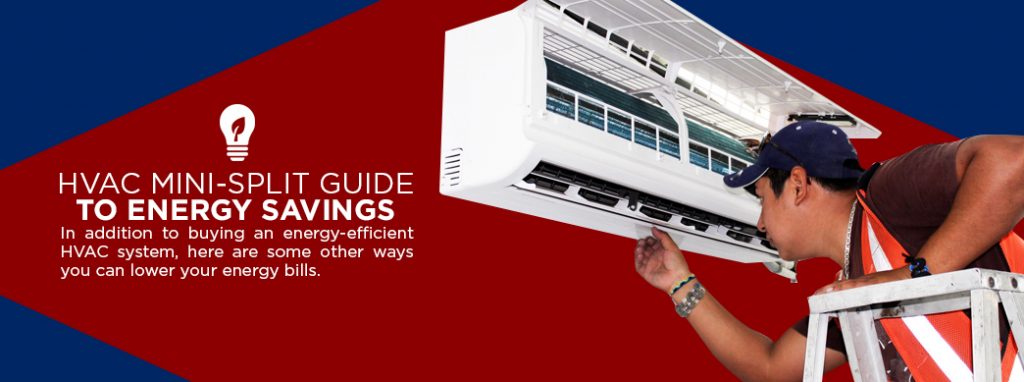
While these upfront costs may be high, keep in mind you’ll recover the costs through energy savings from your ductless HVAC system, and Energy Star-certified models consume 60% less than traditional heating systems.
In addition to buying an energy-efficient HVAC system, here are some other ways you can lower your energy bills.
- Choose moderate temperatures: In the summer, try to choose a slightly warmer temperature and slightly lower temperature in the winter so your system won’t have to work as hard to attain the temperature you’ve set. Chances are, you’ll notice a difference on your power bill.
- Clean the filters and coils: By keeping the filters and coils clean and clear, your unit can produce the same amount of heated or cooled air using less energy.
- Oil the machinery and tighten the belts: These two practices will also help your system use less energy.
Ductless Systems for Commercial Buildings
For office buildings and other commercial facilities, VRF HVAC systems are the recommended route. Unlike a traditional residential ductless unit, VRF systems offer simultaneous heating and cooling to different parts of the building. A VRF system offers businesses:
- Quieter Operation
- Energy Efficiency
- Flexible Heating and Cooling Options
- Simpler Installation
Home Climates can help guide you to the appropriate heating and cooling solution for your business.
Ductless HVAC Installation in Central PA
Now that you’ve read this guide for ductless HVAC mini-split systems, if you live in Central Pennsylvania and are looking for a cost-effective way to stay comfortable during our state’s hot, humid summers and cold winters, consider buying a mini-split from Home Climates. Our office is in Elizabethtown, a convenient location that allows us to service Lancaster, Dauphin, Cumberland, York and Lebanon counties, with our priority towns being Lancaster, Hershey, Hummelstown, Mount Joy and Elizabethtown.
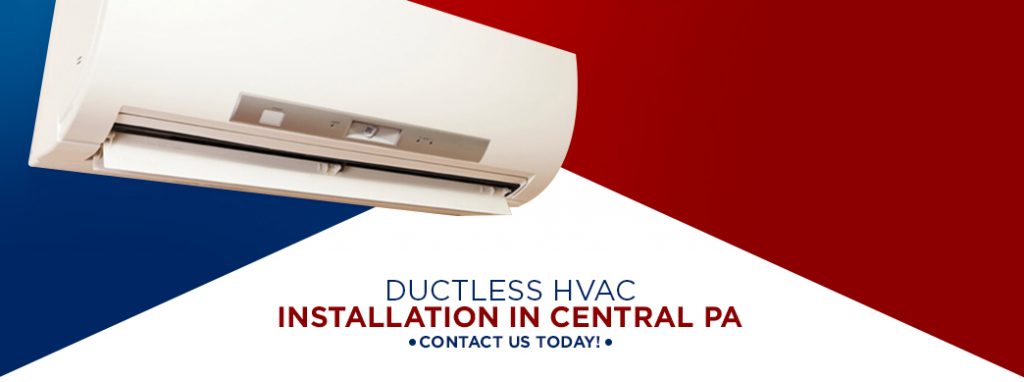
We can help you select the best ductless mini-split air conditioner and heat pump system for your needs. In addition to selling, servicing and installing ductless mini-splits, we also offer a variety of other HVAC services. Our professional technicians provide services such as air quality evaluation, furnace installation, maintenance and tune-ups. Our team installs geothermal heating systems and Nest smart thermostats to ensure your home has the best equipment and materials to maximize its energy efficiency.
Learn more about Ductless Installations
Alongside our quality products and services, we also strive to provide the best customer service experience possible, which is why we offer our customers a variety of warranties and rebates.
- HVAC parts and labor warranties: We offer a parts warranty for every HVAC installation we perform, as well as a labor warranty, so you can trust the installations we perform will work well for many years to come. When we finish our installation, we also make sure to provide our customers with a thorough walkthrough of their new system, so they have a full understanding of how to operate it. We also make sure to leave the property just as we found it and use dropcloths and booties during every installation to ensure we don’t make a mess.
- Current HVAC rebates: We always provide our customers with standard rates and fair pricing to make sure their projects won’t cost more or go on for longer than expected. We respect your budget and want to help maintain it. We can assist you in choosing an energy-efficient system that is eligible for rebates through utility providers. Our technicians would be glad to provide you with more information.
If you need emergency services, an HVAC installation or would like to book a free in-home ductless HVAC consultation, contact us by calling 717-689-4151 or filling out the contact form on our site.
